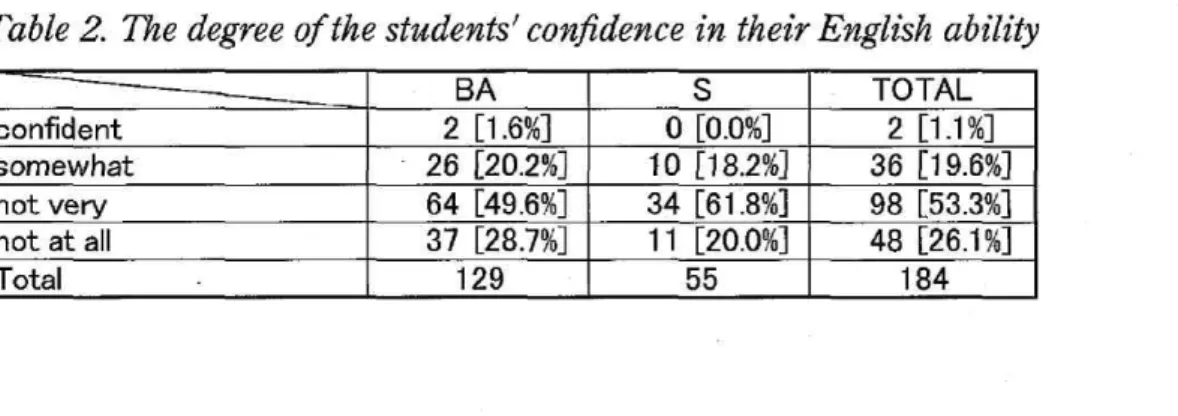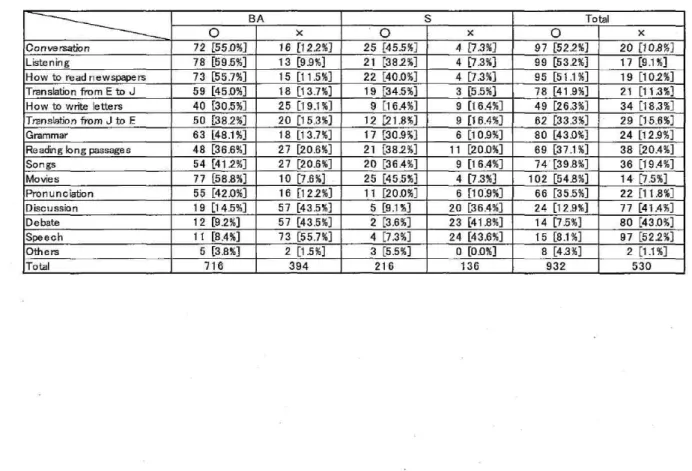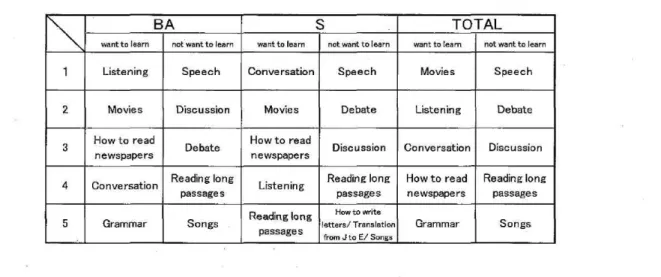Kanagawa University students' views on their English learning
and their motivations
Kazuyuki Shite
Introduction
Since communicative language teaching (CLT) came to play a dominant role in language teaching in the 1980's (Richards and Rodgers, 2001), use of language, rather than knowledge of language, has been a main focus in the instruction of target language. As the world becomes globalized in terms of communication, especially English seems to have a more crucial position as lingua franca. Japan is no exception.
For example, Ministry of Education (MOE) initiated two major reforms in English teaching at the secondary school level. The first is the JET (Japan Exchange and Teaching) program, in which Native English speaking ALTs (Assistant Language Teachers) teach public school English classes in communication-oriented settings in collaboration with JTEs (Japanese Teachers of English). The second is the modification of curriculum. In 1994,
a new high school subject called 'Oral Communication' was introduced to cover three courses: listening, speaking, and discussion/debate.
Furthermore, teaching materials such as textbooks were arranged on communication basis.
Despite the changing trend, there still seems a factor that counters it.
That is, university entrance examinations appear to have an undesirable effect on communicative instruction as many researchers mention (Ike,
1995; Law, 1995). Since a priority is placed on leading students to pass the entrance examinations, secondary level language syllabuses and teaching methodology seem to be molded into the exhibition of 'strong preference for lists of language items over discursive texts, for peripheral over core forms, and for linguistic knowledge over linguistic performance' (Law, 1995, p. 217).
Gorsuch (1998) relates the examinations to yahudoleu and the grammar- translation method in that great standards of accuracy and focus on exceptions to the rules of grammar are involved with English instruction in order to get students to gain higher scores. As Locastro (1990) argues, the underlying reason seems to be that the examinations assess knowledge of and the ability to translate into Japanese a variety of English that is not commonly used. Therefore, 'the richness and depth of natural spoken and informal written language is lost and the range of topics of contemporary discourse is absent' (Locastro, 1990, p. 352).
Moreover, a close look at learners' beliefs about language learning would provide a clear picture of the classroom setting. Matsuura et al (2001) conducted a 36-item questionnaire with over 300 students and 82 college teachers to assess their beliefs about language learning and teaching respectively. It was found that a majority of the students preferred more traditional styles of language teaching, for example, 'learning isolated skills, focusing on accuracy, and learning through a teacher-centered approach' (p. 86). On the other hand, the teachers' responses were different. They tended to express a preference for more communicative instruction such as 'a focus on communication
, learner-centered activities, integrated skills, and a focus on fluency rather than accuracy' (p. 86). The discrepancy between the students' and teachers' beliefs seems to indicate that although teachers try to help learners get more involved with communicative use of language at classroom, learners might have a difficulty in adjusting their learning style to communicative instruction due to their conservative attitude toward language learning.
This paper tries to explore affective part of English learning for Japanese
70 EsiggraftNo.32 2006
learners of English. The author is currently teaching English at Kanagawa University. The present study is expected to shed light on Kanagawa University students' views on their English learning and their motivations.
Research Questions
1. What do Kanagawa University students think of their English learning?
2. How was their English learning until they graduated from high school?
3. What do they want to learn at university English classroom?
Methodology Participants
Those who took part in the present study were the first-year students of Business Administration (BA) (n=131), and the second-year students of Science (S) (n=55) at Kanagawa University. According to the results of the placement test, which students take before a semester begins, they are allocated into a certain level of English proficiency slot so that they study with peers whose proficiency levels are similar to each other. The survey was conducted in each of the two semesters: Spring and Fall semester.
Some students take the same level of classes in both semesters due to their almost identical scores of the placement test. Thus, seven students of BA and eight students of Science were overlapped in the data. It must be noted that it was impossible to identify the overlapped data because of their anonymity. The author takes charge of six English classes as in the following table.
The levels of the classes targeted
Business Administration Science
Period Level
Tue: 2nd Tue: 4th Fri: 1st Fri: 3rd Period
*2 Level
Tue: 3rd Fri: 2nd
Advanced-a a
Advanced-b b
Intermediate-a c 0
Intermediate-b d
Intermediate-c • e •
Intermediate-d f
Intermediate-e •
g
Intermediate-f h
Beginner-a
Beginner-13
Basic-a 0
Basic-b
The mark `•' is a kind of class the author teaches.
*l&zI
n both class types, proficiency levels decrease in an alphabetical order.
They were asked to fill out a questionnaire during the first ten minutes of the first English class. They had not been informed of this survey in advance.
Materials & Tasks
The questionnaire was given to each participant in the class. The questions had been derived from the questionnaire administered at Obirin University (Matsuda, 1993) and arranged for the current study. Since open-
ended questions were discarded as unnecessary qualitative data, the current questionnaire, written in Japanese, consisted of five types of questions, four of which has a rating scale (see Appendix for reference to its example):
1. Do you like English? .
2. What do you think of your English proficiency?
72 an,gNo.32 2006
3. What do you think of the English classes you had taken by the time you graduated from high school?
4. Do you have any qualifications of English?
5. What do you or don't you want to study?
The first three questions were expected to draw some inferences about students' motivation for learning English. The next question was to indicate their English proficiency and the last was to show what they hope to learn or not to learn at university English classroom.
Results
All the data on the questionnaire were quantified and analyzed. Table 1 shows the participants' view on English in terms of if they like or dislike it.
Table 1. The students' views on English
BA S TOTAL
I like English. 66 [50.4%] 23 [41.8%] 89 [47.8%]
I dislike English. 65 [49.6%] 32 [58.2%] 97 [52.2%]
Total 131 55 186
The overall data tell us that the number of those who dislike English exceeds that of those who like by eight. In addition, whereas all the BA students are almost equally split up into half in terms of whether they like English or not, about 58% of Science students do not like English, which infers a tendeney to dislike English. However, the difference is still small.
Table 2 shows that how confident students are in their English skills.
Table 2. The degree of the students' confidence in their English ability
BA S TOTAL
confident 2 [1.6%] 0 [0.0%] 2 [1.1%]
somewhat 26 [20.2%] 10 [18.2%] 36 [19.6%]
not very 64 [49.6%] 34 [61.8%] 98 [53.3%]
not at all 37 [28.7%] 11 [20.0%] 48 [26.1°4
Total 129 55 184
The majority of the students (53.3%) are not very confident in their English ability and about 26% of the students are not confident at all. This indicates that about 80% of the students have a negative impression on their English ability. Moreover, each department of the students shows a similar tendency.
Table 3 shows what the students think of the English classes they had taken by the time they graduated from high school.
Table 3. What they think of the English classes they had taken by the time of high school graduation
BA S TOTAL
interesting 28 [21.4%] 13 [23.6%] 41 [22.0%]
uninteresting 70 [53.4%] 15 [27,3%] 85 [45.7%]
uninteresting, but useful* 27 [20.6%] 24 [43.6%] 51 [27.4%]
others 6 [4.6%] 3 [5.5%] 9 [4.8%]
Total 131 55 186
*useful for university entrance examinations
About 46% of the students think the previous English classes are not interesting. When the third category, which is 'uninteresting, but useful for university entrance examinations,' is included, about 73% of the students
consider the English classes to be uninteresting. On the other hand, the second and third categories show that BA and Science students have opposite attitudes toward practicality. That is, while about 74% of BA students think that the English classes were uninteresting, and only about 28% of the students who think so consider the classes to be useful, about 71% of Science students think that the classes were uninteresting, but about 61.5% of the students who think so consider the classes to be useful.
Table 4 .shows the number of students who have a qualification of English.
74 EIMIMVA No.32 2006
Table 4. The number of the students who have a qualification of English
BA S TOTAL
Eiken 2nd 2 [1.5%] 2 [3.6%] 4 [2.2%]
Eiken pre 2nd 22 [16.8%] 11 120.0%] 33 [17.7%]
Eiken 3rd 27 [20.6%] 9 [16.4%] 36 [19.4%]
Eiken 4th 2 [1.5%] 4 [7.3%] 6 [3.2%]
Eiken 5th 0 [0.0%] 1 [ 1.8%] 1 [0.5%]
others 4 [3.1%] 0 [0.0%] 4 [2.2%]
Total 55 [42.0%] 25 [45.5%] 80 [43.0%]
Overall, 43% of the students have a qualification of English. Most of them (95%) hold Eiken (Test in Practical English Proficiency). The majority of them have either Eiken pre second-degree (17.7%) or Eiken third-degree (19.4%). There seems to be any big difference between both groups.
Table 5 shows what the students want to learn in English classes and what they don't. In addition, Table 6 shows the top five things they want to learn and the top five things they do not want to learn.
Table 5. What the students want to learn and what not in university English classes
BA S Total
0 0 x 0 x
Conversation 72 [55.0%] 16 [12.2%] 25 [45.5%] 4 [7.3%] 97 [52.2%] 20 [10.8%]
Listening 78 [59.5%] 13 [9.9%] 21 [382%] 4 [7.3%] 99 [53.2%] 17 [9.1%]
How to read newspapers 73 [55.7%] 15 [11.5%] 22 [40.0%] 4 [7.3%] 95 [51.1%] 19 [10.2%]
Translation from E to J 59 [45.0%] 18 [13.7%] 19 [34.5%] 3 [5.550 78 [41.9%] 21 [113%]
How to write letters 40 [30.5%] 25 [19.190 9 [16.4%] 9 [16.4%] 49 [26.3%] 34 [18.3%]
Translation from J to E 50 [38.2%] 20 [15.390 12 [21.8%] 9 [16.4%] 62 [33.3%] 29 [15.6%]
Grammar 63 [48.1%] 18 [13.7%] 17 [30.9%] 6 [10.9%] 80 [43.0%] 24 [12.9%]
Reading long passages 48 [36.6%] 27 [20.6%] 21 [38.2%] 11 [20.0%] 69 [37.190 38 [20.4%]
Songs 54 [41.2%] 27 [20.6%] 20 [36.4%] 9 [16.4%] 74 [39.8%] 36 [19.4%]
Movies 77 [58.8%] 10 [7.6%] 25 [45.5%] 4 [7.390 102 [54.8%] 14 [7.590
Pronunciation 55 [42.0%] 16 [12.2%] 11 [20.0%] 6 [10.9%] 66 [35.5%] 22 [11.8%]
D isc u ssio n 19 [14.5%] 57 [43.5%] 5 [9.190 20 [36.4%] 24 [12.9%] 77 [41.4%]
Debate 12 [9.2%] 57 [43.5%] 2 [3.696] 23 [41.8%] 14 [7.5%] 80 [43.0%]
Speech 11 [8.4%] 73 [55.7%] 4 [7.3%] 24 [43.6%] 15 [8.196] 97 [522%]
Others 5 [3.8%] 2 [1.550 3 [5.5%] 0 [0.0%] 8 [4.350 2 [1.190
Total 716 394 216 136 932 530
Table 6. The top five things they want to learn and they do not
BA S TOTAL
want to learn not want to learn want to learn not want to learn want to learn not want to learn
1 Listening Speech Conversation Speech Movies Speech
2 Movies Discussion Movies Debate Listening Debate
3 How to read
newspapers Debate How to read
newspapers Discussion Conversation Discussion
4 Conversation Reading long
passages Listening Reading long
passages
How to read newspapers
Reading long passages
5 Grammar Songs Reading long
passages
How to write letters/ Translation from J to E/ Songs
Grammar Songs
They seem to have a preference for receptive skills such as listening and reading and have a tendency to avoid handling productive skills such as speech and debate. When each department is given a close look, similar phenomena can be seen.
Discussion
Although the data collected by means of a questionnaire were not analyzed with a complex statistical method, interesting phenomena seem to be observed. The majority of Kanagawa students do not possess a positive impression on their English ability, which may lead them to think they do not have a preference for this subject.
Their negative attitude toward English learning seems attributed to their past learning. About 73% of students think the English classes they had taken by the time of high school graduation were uninteresting. With regard to the difference between both departments in this respect, the Science students tend to consider the previous English classes to be more useful for university entrance examinations than the BA students though they think the classes were uninteresting. In other words, it seems that the Science students had a tendency to be grounded in instrumental motivation, which is more practical, rather than integrative motivation, which is based on a desire to know more about the culture and community of the target
76 Eirgagirgf No.32 2006
language group (Dornyei, 1990). It may be interesting to investigate the relationship between their preference for English and what they think of the previous English classes.
Furthermore, the qualifications the students hold seem to indicate that their English ability is not sufficient for university level due to the fact that only about 2% of the students possess Eiken 2nd, which are designed for a level of high school graduates. However, this might be too early to say so because the fact that those who do not take English proficiency tests does not guarantee that their English ability is not sufficient.
Similar to Matsuura et al (2001), the students seem to prefer studying receptive skills to productive skills even though the importance of English communication has been widely accepted. This seems to infer that when we implement communicative tasks into classroom, we must provide them for the students with much care, considering that the majority of the students have a negative attitude toward their English learning.
Conclusion
As for classroom situations, Dornyei (2001) states "although there is ample indirect evidence that the teacher's own level of motivation is 'infectious'
, that is, it has a significant impact on the students learning commitment, hardly any research has been done in the past to explore this relationship" (p. 50). Although it is very challenging to measure personal factors such as motivations, no doubt can be cast to the importance of affective domains in the theory of second language learning (Brown, 2000) from learners' and teachers' perspectives. It is hoped that the present study will play a role in helping Kanagawa University teachers plan, execute, and assess their communicative teaching.
References
Brown, H.D. (2000). Principles of Language Learning and Teaching. New York:
Prentice Hall.
Dornyei, Z. (2001). New themes and approaches in second language
motivation research. Annual Review of Applied Linguistics,21, 43
Dornyei, Z. (1990). Conceptualizing motivation in foreign language learning.
Language Learning, 40, 45-78.
Gorsuch, G. J. (1998). Yakudoku EFL instruction in two Japanese high school classrooms: An exploratory study. JALTJournal, 20, 6-32.
Ike, M. (1995). A historical review of English in Japan (1600-1880). World Englishes, 14, 3-11.
Law, G. (1995). Ideologies of English language education in Japan. JALT Journal, 17, 213-224
Locastro, V. (1990). The English in Japanese University entrance
examinations: A sociocultural analysis. World Englishes, 9, 343-354.
Matsuda, M. (1993). Hasshingata Kyoileu No Jissen. Tokyo: Sanshusha.
Matsuura, H., Chiba, R., & Hilderbrandt, P. (2001). Beliefs about learning
and teaching communicative English in Japan. JALT Journal, 23, 69-89.
Richards, J. C., & Rodgers, T. S. (2001). Approaches and Methods in Language
Teaching. New York: Cambridge University Press.
78 -g-No.32 2006
Appenda.x
Questionnaire
該 当 す る 番 号 に0を つ け 詳 し い こ と は()に 記 入 し て く だ さ い 。
A.英 語 は 好 き で す か 。
1,は い2.い い え
理 由()
B.自 分 の 英 語 能 力 を ど う 思 い ま す か 。
1.自 信 が あ る2.ふ つ う3.あ ま り 自 信 が な い 特 に()が 苦 手
4,全 く 駄 目
C.高 校 ま で の 英 語 の 授 業 を ど う 思 い ま す か 。
1.面 白 か っ た2.つ ま ら な か っ た 理 由()
3.面 白 く は 無 か っ た が 受 験 に は 役 に 立 っ た 』
4.そ の 他()
D.英 語 の 資 格(TOEFL、TOEIC、 英 検 等)を 持 っ て い た ら 書 い て く だ さ い 。
例(TOEIC505点)
E.大 学 の 授 業 で や っ て み た い こ と に は ○ 、や り た く な い こ と に は × を つ け て く だ さ い 。 こ の 授 業 に 限 ら ず 全 般 的 に 答 え て く だ さ い 。(複 数 回 答 可)
1.英 会 話2.リ ス ニ ン グ3.英 字 新 聞 の 読 み 方4.英 文 和 訳5.
英 文 レ タ ー の 書 き 方6.和 文 英 訳7.文 法8.長 文 読 解9.英 語
の 歌10.洋 画11.発 音12,英 語 で の デ ィ ス カ ッ シ ョ ン13.
デ ィ ベ ー ト14,ス ピ0チ
ユ5.そ の 他(具 体 的 に)
F.こ の 授 業 はLis七ening&Speakingを 扱 い ま す が ど の よ う な 内 容 を 期 待 し ま す か 、
ま た 具 体 的 に ど の よ う な 技 能 を 身 に つ け た い と 思 い ま す か 。
例(英 語 で 日 常 会 話 が で き る よ う に な り た い 。)


